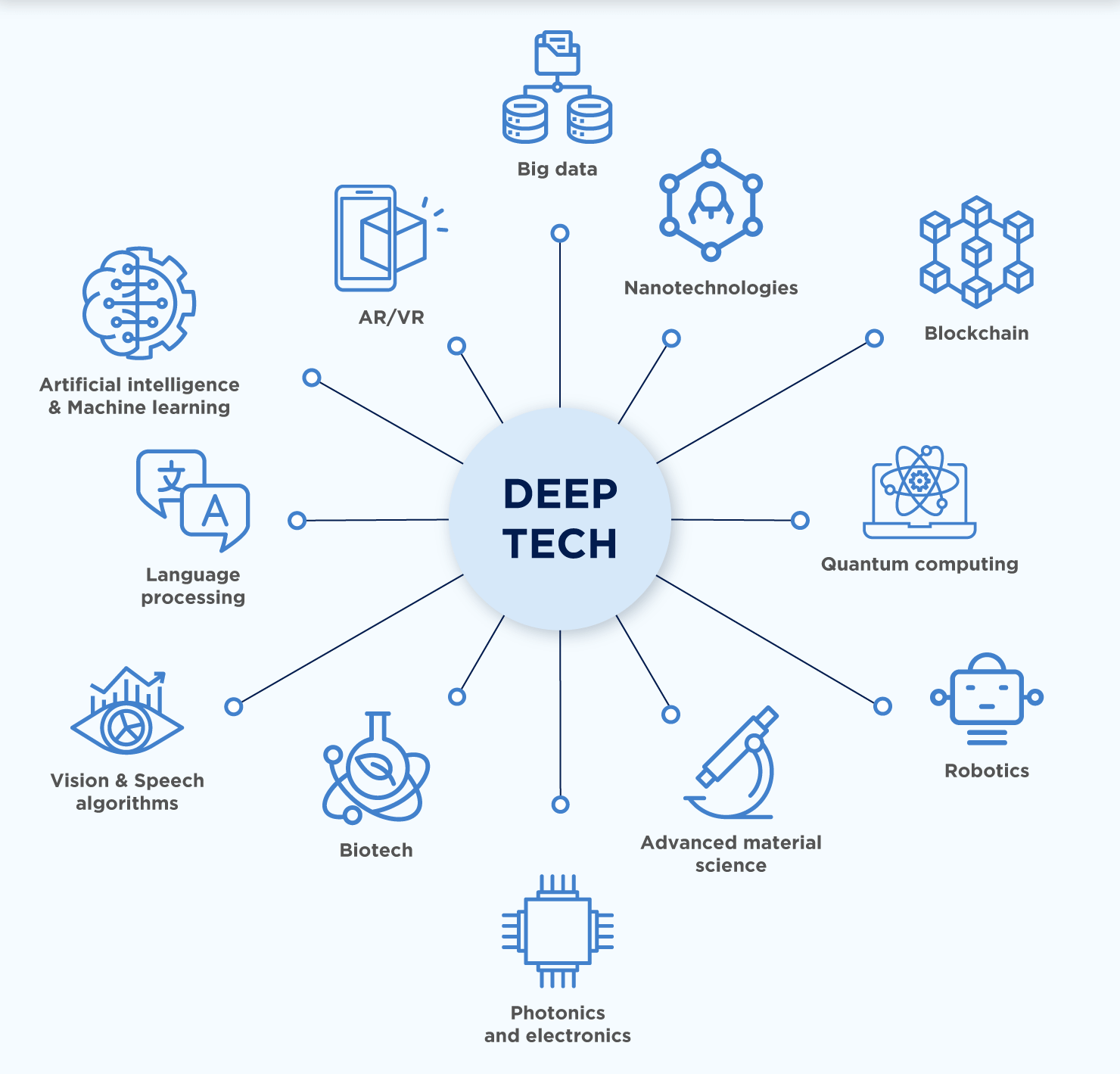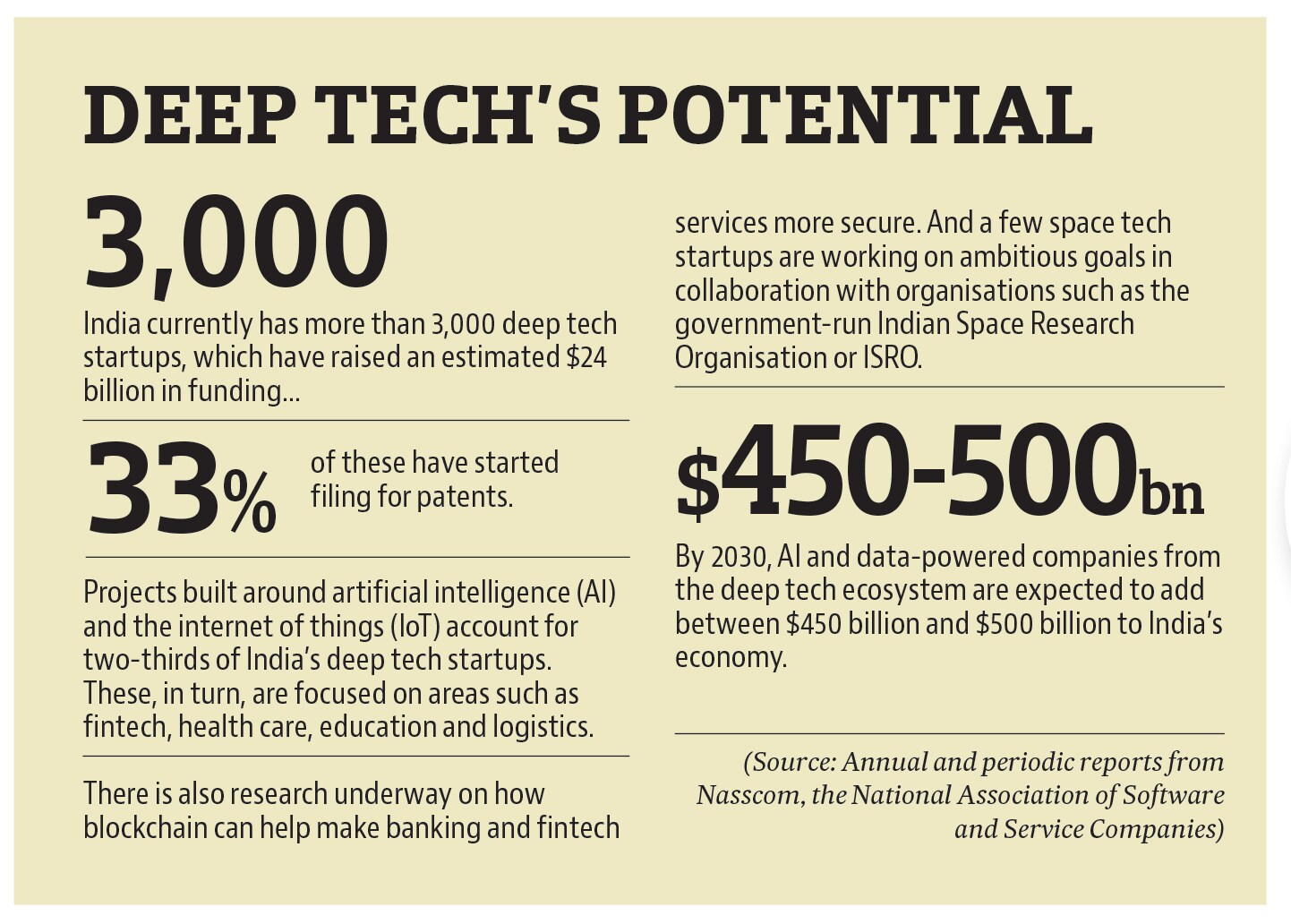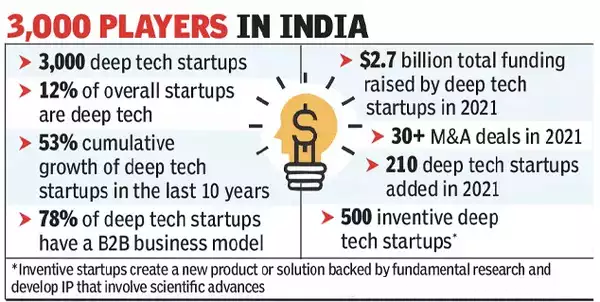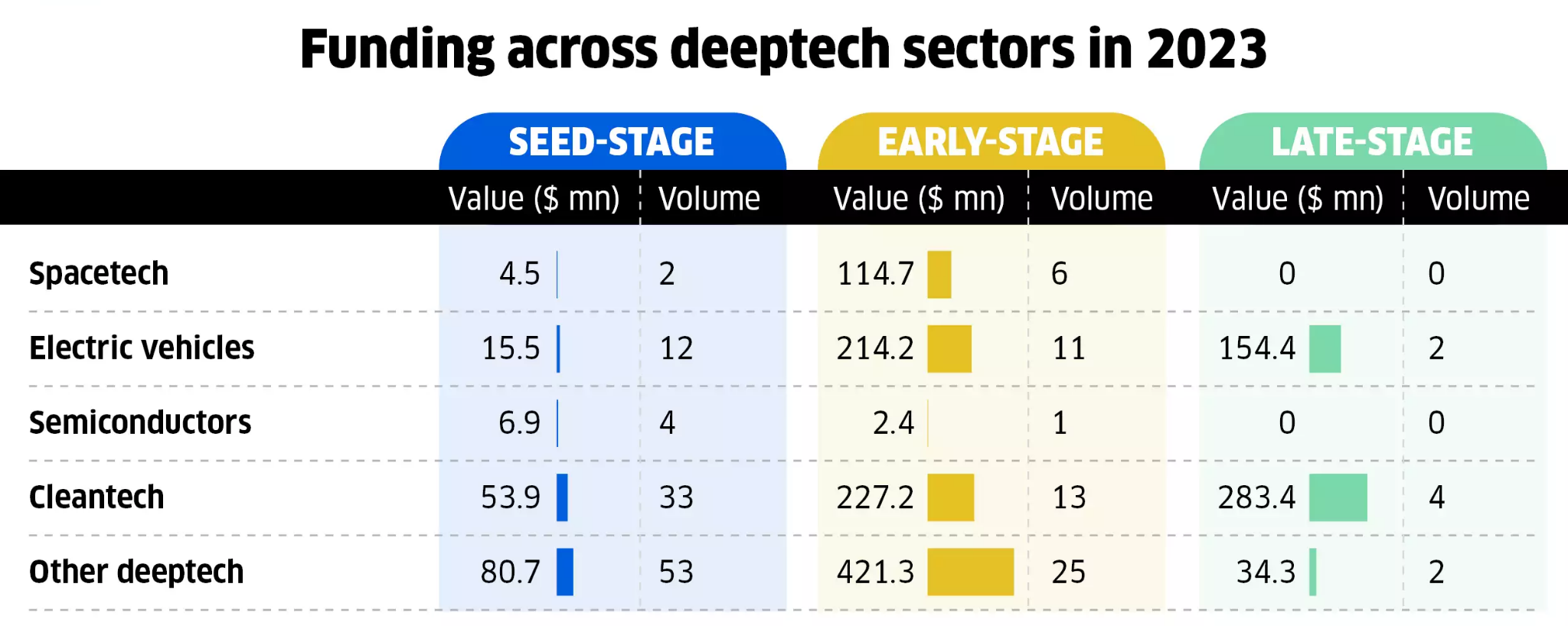Science & Technology
India's Ambitious Push for Deep Tech
- 09 Feb 2024
- 14 min read
For Prelims: Deep Tech Startups, Deep Tech, Artificial Intelligence, Machine Learning, Internet of Things, Big Data, quantum computing
For Mains: Deep Tech Startups and India
Why in News?
During her Interim Budget address, the Finance Minister unveiled a Rs 1 lakh crore fund aimed at offering long-term, low-cost, or zero-interest loans for research and development initiatives.
- She also pledged to introduce a new program to enhance deep-tech capabilities in defense, hinting at a broader policy to support deep-tech startups across various sectors, expected later this year.
What is Deep Tech?
- About:
- Deep tech or deep technology refers to a class of startup businesses that develop new offerings based on tangible engineering innovation or scientific discoveries and advances.
- Deep tech fields like Artificial Intelligence, advanced materials, blockchain, biotechnology, robotics, drones, photonics, and quantum computing are moving more and more quickly from early research to market applications.
- Characteristics of Deep Tech:
- Impact: The deep tech innovations are very radical and disrupt an existing market or develop a new one. Innovations based on deep tech often change lives, economies, and societies.
- Time & Scale: The time required for deep technology to develop the technology and reach market-ready maturity is way more than shallow technology development (like mobile apps and websites).
- Capital: Deep tech often requires a lot of early-stage funding for research and development, prototyping, validating hypothesis, and technology development.
Why Deep Tech Matters?
- Addressing Global Challenges: Deep tech is poised to play a crucial role in addressing complex global issues including climate change, hunger, epidemics, energy access, mobility, and cyber security. These innovations offer promising solutions to pressing societal and environmental challenges.
- Scientific Advancement: Deep tech encompasses cutting-edge scientific research and technological development in fields such as artificial intelligence, biotechnology, quantum computing, and more. Advancements in these areas push the boundaries of human knowledge and understanding, leading to breakthroughs that benefit society as a whole.
- Economic Growth and Competitiveness: Investing in deep tech drives economic growth by fostering innovation, creating high-value jobs, and stimulating entrepreneurship. Countries and companies that lead in deep tech innovation gain a competitive edge in the global marketplace, attracting investment, talent, and opportunities for collaboration.
- Disaster Management: Deep tech solutions contribute to disaster preparedness and response efforts. For example, AI-powered predictive models can forecast natural disasters like hurricanes and earthquakes with greater accuracy, enabling authorities to evacuate populations at risk and allocate resources more efficiently.
- Counterterrorism: Deep tech enables the development of advanced surveillance systems, biometric identification techniques, and predictive analytics tools, which are instrumental in combating terrorism.
- These technologies help identify and track individuals involved in extremist activities, disrupt terrorist networks, and prevent future attacks.
What is the State of India’s Deep Tech Startups?
- Strengths and Opportunities
- India boasts a significant pool of high-quality science and engineering talent along with a burgeoning technology culture. This positions the country as a frontrunner in the development and adoption of deep-tech solutions.
- India had over 3,000 deep-tech start-ups, dabbling in new-age technologies like Artificial Intelligence, Machine Learning (ML), the Internet of Things, Big Data, quantum computing, robotics, etc., at the end of 2021.
- According to NASSCOM, deep-tech start-ups in India raised USD 2.7 billion in venture funding in 2021, and now account for over 12% of the country’s overall startup ecosystem.
- In the last decade India’s deep tech ecosystem has grown 53% and is at par with that in developed markets like the US, China, Israel, and Europe.
- Bengaluru accounts for 25-30% of India’s deep-tech start-ups, followed by Delhi-NCR (15-20%) and Mumbai (10-12%).
- Potential Contributions
- India has the potential to contribute significantly to the advancement of deep tech, fostering early adoption, intellectual property sharing, indigenous knowledge development, and self-reliance.
- This can lead to spin-off technologies, skilled workforce development, entrepreneurship, and technology exports.
- Deep-tech start-ups are making their presence felt across sectors like drone delivery and cold chain management to climate action and clean energy.
- India has the potential to contribute significantly to the advancement of deep tech, fostering early adoption, intellectual property sharing, indigenous knowledge development, and self-reliance.
How the Government is Establishing an Ecosystem for Deep Tech Startups?
- The government has been actively promoting research and innovation in transformative technology areas, such as mobility, battery storage, and quantum technology.
- Initiatives like the National Mission on Transformative Mobility and Battery Storage and the National Quantum Mission are examples of these efforts.
- Policy Framework Development:
- In 2023, a policy framework aimed at fostering an enabling environment for companies operating in deep tech sectors was finalized. Known as the National Deep Tech Startup Policy (NDTSP), it is currently awaiting government approval.
- This policy is a collaborative effort between the Department for Promotion of Industry and Internal Trade and the Office of the Principal Scientific Adviser.
- Objectives of the Policy: The NDTSP is designed to address the specific challenges encountered by technology startups and to provide them with a conducive platform to compete and collaborate globally.
- Key Focus Areas: The NDTSP outlines several key areas that require attention to achieve its objectives:
- Long-term Funding Opportunities: Creating mechanisms for sustained financial support to enable deep tech startups to thrive.
- Intellectual Property Rights Regime: Establishing a simplified yet robust framework to protect intellectual property, fostering innovation and confidence among startups.
- Tax Incentives: Providing tax benefits to incentivize investment in research and development within the deep tech sector.
- Conducive Regulatory Framework: Developing regulations that support and facilitate the growth of deep tech startups while ensuring compliance and safety.
- Standards and Certifications: Setting industry standards and certifications to ensure quality and reliability in deep tech products and services.
- Talent Nurturing: Investing in the development of skilled professionals and fostering a talent pool conducive to deep tech innovation.
- Industry-Academia Collaboration: Facilitating linkages between industry, research institutions, and educational establishments to promote knowledge exchange and collaboration.
- By addressing these critical areas, the NDTSP aims to lay the groundwork for a robust and sustainable ecosystem that fosters innovation and growth in the deep tech startup landscape.
- In 2023, a policy framework aimed at fostering an enabling environment for companies operating in deep tech sectors was finalized. Known as the National Deep Tech Startup Policy (NDTSP), it is currently awaiting government approval.
- National Research Foundation (NRF) Implementation: The government has established National Research Foundation (NRF), which aims to cultivate synergies between different sectors for research advancement.
- It is anticipated that around 70% of the NRF's funding, totaling Rs. 50,000 crore over five years, will originate from private industry contributions.
What are the Challenges faced by Deep Tech Projects?
- High Risk and Long-term Return on Investment: Deep tech projects often require significant upfront investment in research and development, and may take years or decades to reach the market and generate revenue. This makes them less attractive for traditional investors, who prefer lower-risk and shorter-term ventures.
- Scarcity of Specialized Talent: Deep tech projects need highly skilled and experienced researchers, engineers, and entrepreneurs, who are in short supply and high demand. Finding and retaining such talent can be difficult and costly for deep tech startups, especially in emerging markets.
- Lack of Market Readiness: Deep tech projects may face regulatory, ethical, social, or environmental barriers that limit their adoption and scalability. They may also need to educate and convince potential customers and stakeholders about the value and feasibility of their solutions, which can be complex and unfamiliar.
- Insufficient Research Funding in India: Inadequate research funding in India persists despite a target of 2% GDP allocation. While absolute spending on R&D has risen, the proportion relative to GDP has declined, currently standing at 0.65%, well below the global average of 1.8%.
- This financial shortfall hampers India's competitiveness with scientifically advanced nations, signaling a concerning trend in diminishing support for crucial research activities.
- Skepticism within the Scientific Community: Despite the government's efforts, skepticism persists within the scientific community. Many doubt the efficacy of relying solely on the private sector for funding research. They argue that government funding remains crucial and that expectations for private investment may be overly optimistic.
- Financial Inadequacy: Despite the government's focus on innovation, budgetary increments for key departments are modest. The Council of Scientific and Industrial Research (CSIR) and the Department of Space, for example, see marginal increases, while others face budget cuts.
- Bureaucratic Hurdles: Even when funds are available, delays and bureaucratic hurdles often hinder their effective disbursement. Complex administrative procedures contribute to interruptions in project funding, hampering research progress.
Way Forward
- Enhance the Role of Public-Private Partnerships in Research Funding: Recent government initiatives suggest a shift towards fostering partnerships with the private sector to bolster R&D investment. Recognizing the limitations of public funding alone, efforts are underway to enhance collaboration among industry, research institutions, and educational bodies.
- Ensure Optimum Utilisation of Funds: The Rs 1 lakh crore corpus is intended to provide seed funding for startups and private sector ventures engaged in research and development.
- However it should be ensured that the allocated fund is properly utilised timely release for funds must also be enured.
- Strengthening intellectual property rights: Deep tech startups rely on their intellectual property (IP) to protect their innovations and gain a competitive edge. The government can streamline and simplify the IP registration and enforcement process, and provide more awareness and assistance to deep tech startups on IP-related matters.
- The private sector and academia can also encourage and reward IP creation and commercialization among deep tech startups.
- Building human capital and talent pipeline: The government, private sector, and academia can work together to enhance the quality and quantity of deep tech education and training, and create more opportunities for deep tech talent to connect, collaborate, and learn from each other.
- The government can also facilitate the mobility and immigration of foreign deep tech talent to India, and provide more incentives and benefits for them to work and stay in India.
Conclusion
The government's announcement of a Rs 1 lakh crore fund for R&D, coupled with initiatives to fortify deep-tech capabilities, signals a watershed moment in India's innovation journey. However, challenges still remain in the path which need a careful attention.
UPSC Civil Services Examination, Previous Year Question (PYQ)
Prelims:
Q. Atal Innovation Mission is set up under the (2019)
(a) Department of Science and Technology
(b) Ministry of Labour and Employment
(c) NITI Aayog
(d) Ministry of Skill Development and Entrepreneurship
Ans: (c)
Mains:
Q. COVID-19 pandemic has caused unprecedented devastation worldwide. However, technological advancements are being availed readily to win over the crisis. Give an account of how technology was sought to aid management of the pandemic. (2020)









